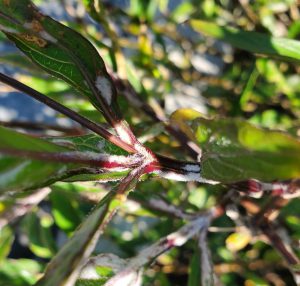
When does a blight on a plant look like a disease, but is not? A Mexican petunia with a disease-like condition that is actually caused by microscopic mites is the answer! Many gardeners who have Mexican petunias experience this plague from time to time. It looks just like a fungus but is actually caused by a minute arachnid called an eriophyid mite.
Now, I am not promoting Ruellia simplex as they have an invasive nature and according to the Florida Exotic Pest Plant Council or FLEPPC, it is a “CATEGORY I Invasive exotics that is altering native plant communities by displacing native species, changing community structures or ecological functions, or hybridizing with natives. This definition does not rely on the economic severity or geographic range of the problem, but on the documented ecological damage caused.” Also, UF/IFAS Assessment of Non-Native Plants in Florida’s Natural Areas indicates that Ruellia simplex is not recommended as it is invasive. However, the sterile cultivars ‘Purple Showers’, ‘Mayan White ™’, ‘Mayan Purple ™’ and ‘Mayan Pink ™’ can be used with caution so that they do not escape.
So, with that information unpacked, let’s get back to our main topic – fuzzy white distorted growth on Mexican Petunias. As mentioned, this damage is caused by an eriophyid mite. The mites feed on the leaves causing
felt-like galls to develop giving the appearance of a powdery or downy mildew infection. This does not kill the plant but does reduce its ornamental appeal.
Least-toxic management of the eriophyid mite involves the use of horticultural oil – applied as per label directions and not in the heat of the day as it will burn the leaves – every five to seven days for a total of three applications. This will take care of this battle, but mites may return, so monitor frequently to suppress any small infestations.
Although microscopic, there should be no mystery about eriophyid mites as they are the real cause of the wooly leaves on Mexican petunias – easily managed with a least-toxic approach. For more information on all types of plant pests and disorders, or to ask a question, you can also call the Master Gardener Volunteer Helpdesk on Mondays, Wednesdays, and Fridays from 1 to 4 pm at 764-4340 for gardening help and insight into their role as an Extension volunteer. Ralph E. Mitchell is the Director/Horticulture Agent for UF/IFAS Extension – Charlotte County. He can be reached at 941-764-4344 or ralph.mitchell@charlottecountyfl.gov . Connect with us on social media. Like us on Facebook @CharlotteCountyExtension and follow us on Instagram @ifascharco.
Resources:
Caldwell, D. (2009) White stuff on Mexican petunia—. The University of Florida Extension Service, IFAS – Collier County.
2019 Florida Exotic Pest Plant Council – https://bugwoodcloud.org/CDN/fleppc/plantlists/2019/2019_Plant_List_ABSOLUTE_FINAL.pdf .
The UF/IFAS Assessment of Non-native Plants in Florida’s Natural Areas. (2023) The University of Florida Extension Service, IFAS.
Wilson, S. B., Burkhead, A., Adams C. R., and Freyre, R. (2020) NATURAL AREA WEEDS: MEXICAN PETUNIA (RUELLIA SIMPLEX). The University of Florida Extension Service, IFAS.
Borden, M. (2023) Eriophyid Mites: What They Are and How to Control Them in the Home Garden. Fine Gardening. https://www.finegardening.com/article/eriophyid-mites-what-they-are-and-how-to-control-them-in-the-home-garden
Source: UF/IFAS Pest Alert
Note: All images and contents are the property of UF/IFAS.



